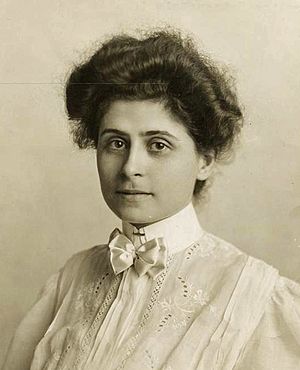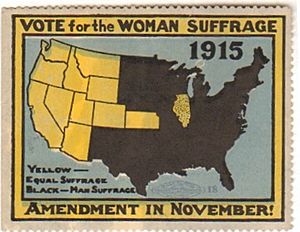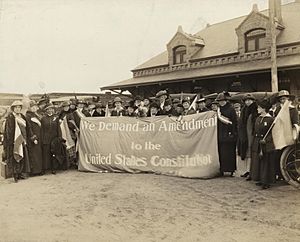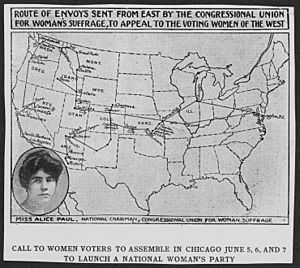Caroline Katzenstein facts for kids
Caroline Katzenstein (1888 – January 31, 1968) was an American suffragist, activist, and writer. A suffragist is someone who worked for women's right to vote. She fought for equal rights for women.
Caroline was very active in the movement in Philadelphia. She worked with groups like the National American Woman Suffrage Association (NAWSA) and the Equal Franchise Society. She also helped start the Congressional Union for Woman Suffrage, which later became the National Woman's Party. Caroline wrote a book called Lifting the Curtain about the fight for women's voting rights.
Contents
Caroline's Early Life
Caroline Katzenstein was born in 1888 in Warrenton, North Carolina. Her parents were Mr. and Mrs. Emil Katzenstein.
In 1907, after her father passed away, Caroline and her family moved to Philadelphia. They lived in a neighborhood called Powelton Village.
Fighting for Women's Rights
The Right to Vote
Caroline Katzenstein joined the fight for women's suffrage in Philadelphia. This was the movement to get women the right to vote. In 1910, when she was 22, Caroline started her first official job in the movement.
She worked as a secretary for the Pennsylvania Woman Suffrage Association. This group was part of the larger National American Woman Suffrage Association (NAWSA). She also worked for the Women Suffrage Society of Philadelphia.
In 1911, Caroline joined a committee for the National American Woman Suffrage Association. She served on this committee for two years.
In 1913, another suffragist named Alice Paul came to Philadelphia. Alice Paul believed that protesting in Philadelphia was important. This was because Philadelphia was where the United States began.
Caroline supported Alice Paul's strong ways of protesting. Alice Paul's methods were considered too strong by NAWSA. So, Alice Paul and her supporters, including Caroline, formed a new group. It was called the Congressional Union for Woman Suffrage. This group later changed its name to the National Woman's Party.
The main difference between these groups was their goal. NAWSA wanted women to get the right to vote state by state. The National Woman's Party wanted a change to the U.S. Constitution. This would give all women across the country the right to vote.
Caroline first stayed loyal to both groups. But tensions grew in NAWSA. So, Caroline left her secretary job with NAWSA in 1914. That same year, she became a publicist and secretary for the Equal Franchise Society of Philadelphia. She even designed a special stamp to promote women's voting rights.
She worked there until early 1916. After Philadelphia rejected a statewide vote for women's suffrage, Caroline realized that state-level changes were not enough. In the spring of 1916, she became the executive secretary for the Congressional Union of Pennsylvania.
The "Suffrage Special" Train
On April 9, 1916, Caroline and 22 other women started a train trip. They traveled from Washington, D.C., to the western United States. They were representatives for the Congressional Union for Woman Suffrage.
The goal of this trip was to get support from women in western states. These women already had the right to vote. The trip also aimed to invite people to a conference in Chicago.
The women traveled for five weeks. They stopped in many states, including Illinois, Kansas, Colorado, and California. They returned to D.C. on May 16.
The "Suffrage Special" trip was a success. The National Women's Party was officially formed in Chicago that June.
Caroline stayed active in the Philadelphia suffrage movement. This was true even when the Nineteenth Amendment to the United States Constitution was passed. This amendment, giving women the right to vote, was ratified on August 26, 1920.
Equal Rights for All Women
After women won the right to vote, Caroline continued her work with the National Woman's Party. When the Women Teachers Organization of Philadelphia needed help, she offered to publicize their fight for equal pay.
In the early 1920s, new laws were passed. These laws made sure that male and female teachers in Philadelphia got the same pay. This win encouraged Caroline to fight for equal rights across the country. She especially supported the Equal Rights Amendment (ERA).
In 1943, Caroline worked with Alice Paul on the Women’s Joint Legislative Committee. During the 1950s, Caroline focused on writing. In 1955, she published her book, Lifting the Curtain. Alice Paul wrote the introduction for her book.
Caroline also wrote essays and articles using the name Carol Stone. She wrote to important politicians, too. These included Presidents Dwight D. Eisenhower, Harry S. Truman, and Richard M. Nixon. She encouraged them to support the ERA.
The ERA was finally passed by Congress in 1971. This was three years after Caroline's death. The amendment is still not fully ratified today.
Caroline's Later Career
After the suffrage movement succeeded, Caroline had a long career. She became a successful insurance agent in Philadelphia. She worked for several companies, including The Equitable Life Insurance Society of New York.
In November 1922, she was recognized as the first woman at the Philadelphia Life Insurance Company to win a special award. It was called the "Leader of Leaders" award. She won it for having the most business that month.
Final Years
Caroline Katzenstein lived on Powelton Avenue in Philadelphia for a long time. She spent her last days at the Regina Nursing Center in Philadelphia. She passed away there on January 31, 1968, at the age of 80.





